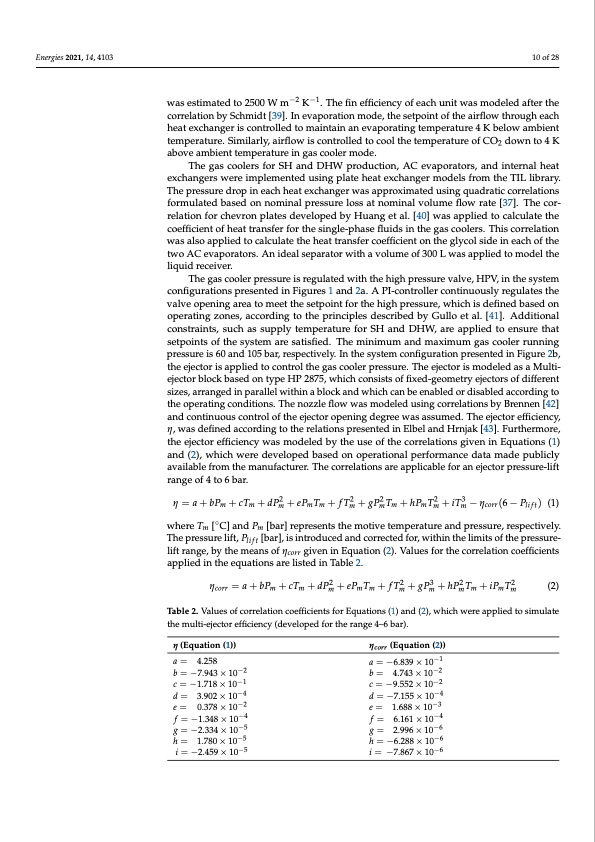
PDF Publication Title:
Text from PDF Page: 010
Energies 2021, 14, 4103 10 of 28 was estimated to 2500 W m−2 K−1. The fin efficiency of each unit was modeled after the correlation by Schmidt [39]. In evaporation mode, the setpoint of the airflow through each heat exchanger is controlled to maintain an evaporating temperature 4 K below ambient temperature. Similarly, airflow is controlled to cool the temperature of CO2 down to 4 K above ambient temperature in gas cooler mode. The gas coolers for SH and DHW production, AC evaporators, and internal heat exchangers were implemented using plate heat exchanger models from the TIL library. The pressure drop in each heat exchanger was approximated using quadratic correlations formulated based on nominal pressure loss at nominal volume flow rate [37]. The cor- relation for chevron plates developed by Huang et al. [40] was applied to calculate the coefficient of heat transfer for the single-phase fluids in the gas coolers. This correlation was also applied to calculate the heat transfer coefficient on the glycol side in each of the two AC evaporators. An ideal separator with a volume of 300 L was applied to model the liquid receiver. The gas cooler pressure is regulated with the high pressure valve, HPV, in the system configurations presented in Figures 1 and 2a. A PI-controller continuously regulates the valve opening area to meet the setpoint for the high pressure, which is defined based on operating zones, according to the principles described by Gullo et al. [41]. Additional constraints, such as supply temperature for SH and DHW, are applied to ensure that setpoints of the system are satisfied. The minimum and maximum gas cooler running pressure is 60 and 105 bar, respectively. In the system configuration presented in Figure 2b, the ejector is applied to control the gas cooler pressure. The ejector is modeled as a Multi- ejector block based on type HP 2875, which consists of fixed-geometry ejectors of different sizes, arranged in parallel within a block and which can be enabled or disabled according to the operating conditions. The nozzle flow was modeled using correlations by Brennen [42] and continuous control of the ejector opening degree was assumed. The ejector efficiency, η, was defined according to the relations presented in Elbel and Hrnjak [43]. Furthermore, the ejector efficiency was modeled by the use of the correlations given in Equations (1) and (2), which were developed based on operational performance data made publicly available from the manufacturer. The correlations are applicable for an ejector pressure-lift range of 4 to 6 bar. η=a+bPm+cTm+dPm2 +ePmTm+fTm2 +gPm2Tm+hPmTm2 +iTm3 −ηcorr(6−Plift) (1) where Tm [◦C] and Pm [bar] represents the motive temperature and pressure, respectively. The pressure lift, Pli f t [bar], is introduced and corrected for, within the limits of the pressure- lift range, by the means of ηcorr given in Equation (2). Values for the correlation coefficients applied in the equations are listed in Table 2. ηcorr =a+bPm+cTm+dPm2 +ePmTm+fTm2 +gPm3 +hPm2Tm+iPmTm2 (2) Table 2. Values of correlation coefficients for Equations (1) and (2), which were applied to simulate the multi-ejector efficiency (developed for the range 4–6 bar). η (Equation (1)) ηcorr (Equation (2)) a = −6.839 × 10−1 b = 4.743 × 10−2 c = −9.552 × 10−2 d = −7.155 × 10−4 a= b= c= d= e= f= g= h= i= 4.258 −7.943 × 10−2 −1.718 × 10−1 3.902 × 10−4 0.378 × 10−2 −1.348 × 10−4 −2.334 × 10−5 1.780 × 10−5 −2.459 × 10−5 e = f = g = 1.688 × 10−3 6.161 × 10−4 2.996 × 10−6 h = −6.288 × 10−6 i = −7.867 × 10−6PDF Image | Evaluation of Integrated Concepts with CO2 for Heating

PDF Search Title:
Evaluation of Integrated Concepts with CO2 for HeatingOriginal File Name Searched:
energies-14-04103-v2.pdfDIY PDF Search: Google It | Yahoo | Bing
CO2 Organic Rankine Cycle Experimenter Platform The supercritical CO2 phase change system is both a heat pump and organic rankine cycle which can be used for those purposes and as a supercritical extractor for advanced subcritical and supercritical extraction technology. Uses include producing nanoparticles, precious metal CO2 extraction, lithium battery recycling, and other applications... More Info
Heat Pumps CO2 ORC Heat Pump System Platform More Info
| CONTACT TEL: 608-238-6001 Email: greg@infinityturbine.com | RSS | AMP |